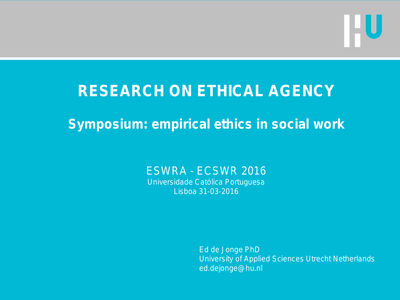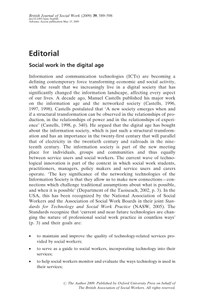Despite the increased attention paid to generational differences especially from practitioners and the popular press, systematic and empirical intergenerational research has been scarce, is largely North American centric, and lacks consistent results. The present study aimed to fill this gap by examining whether differences exist among generations in their key work and organizational attitudes, personal values, and work ethic values in the United States and Turkey. Survey data were gathered from 1019 employees (427 from the U.S. and 592 from Turkey). We found little evidence supporting substantive and significant generational differences or their association with key outcome variables. Furthermore, the U.S. originated classification of generations cannot be generalized to the Turkish business context.
DOCUMENT
Symposium ESWRA - ECSWR 2016: empirical ethics in social work. Objective: ethical aspects of social work (esp. at home) Structure: cooperation of the research group of UAS Utrecht Netherlands with six regional welfare organizations Method: practice based ethics research Focus on professional practice: learning from moral experiences in frontline practice (cf. Van Doorn, 2008) Hybrid approach: combining theoretical resources and professional practice (cf. Banks & Gallagher, 2009) Mixed methods: desk research, interviews, best practice units (BPU), development of ethical tools
DOCUMENT

Inleiding op een themanummer van British Journal of Social Work over sociaal werk in de digitale samenleving.
DOCUMENT

This research aims to contribute to a better understanding of strategic collaborations between work-integration social enterprises (WISEs) and for-profit enterprises (FPEs) with the joint objective to improve labour market opportunities for vulnerable groups. We find that most collaborations strive towards integration or transformation in order to make more social impact.
LINK
BACKGROUND: The capability set for work questionnaire (CSWQ) is being used to measure the new model of sustainable employability building on the capability approach. However, previous studies on the psychometric properties of the instrument are limited and cross-sectional. This two-way study aimed to (1) evaluate the convergent validity of the CSWQ with the theoretically related constructs person-job fit, strengths use, and opportunity to craft and (2) test the predictive and incremental validity of the questionnaire for the well-established work outcomes, including work ability, work engagement, job satisfaction, and task performance.METHODS: A representative sample of 303 Dutch workers, chosen with probably random sampling, were surveyed using a one-month follow-up, cross-lagged design via the Longitudinal Internet Studies for the Social Sciences panel. The convergent validity was assessed by exploring the strength of associations between the capability set for work questionnaire and the theoretically related constructs using Pearson's correlations. The predictive and incremental validity was evaluated by performing a series of linear hierarchical regression analyses.RESULTS: We found evidence of the convergent validity of the capability set score by moderate correlations with person-job fit, strengths use, and opportunity to craft (r = 0.51-0.52). A series of multiple regression analyses showed that Time 1 capability set score and its constituents (i.e., importance, ability, and enablement) generally had predictive and incremental validity for work ability, work engagement, job satisfaction, and task performance measured at Time 2. However, the incremental power of the CSWQ over and above conceptually related constructs was modest.CONCLUSIONS: The findings support the convergent, predictive, and incremental validity of the capability set for work questionnaire with not previously investigated work constructs. This provided further evidence to support its utility for assessing a worker's sustainable employability for future research and practical interventions.
DOCUMENT

Article about social work and social policy in the Netherlands. It gives information about the background, history, the meaning of the profession and the different types of professional areas in which the profession is divided. Other subjects are: social work curricula, the European dimension of social work an current challenges for social professionals in the Netherlands.
DOCUMENT

Article about social work and social policy in the Netherlands. It gives information about the background, history, the meaning of the profession and the different types of professional areas in which the profession is divided. Other subjects are: social work curricula, the European dimension of social work an current challenges for social professionals in the Netherlands.
DOCUMENT

This article discusses the viability of a feminist constructivist approach of knowledge through the careful reading of the work of the feminist scholar and historian of science and technology, Donna Haraway. Haraway proposes an interpretation of objectivity in terms of "situated knowledges". Both the subject and the object of knowledge are endowed with the status of material-semiotic actors. By blurring the epistemological boundary between subject and object, Haraway's narratives about scientific discourse become populated with hybrid subjects/objects. The author argues that the ethics of these hybrid subjects consists of an uneasy mixture of a Nietzschean and a socialist-Christian ethic. The article concludes by setting out why Haraway's project constitutes an interesting effort to fuse postmodern insights and feminist commitments.
DOCUMENT

During the first half of 2020, the outbreak of the COVID-19 virus had a huge global impact. The physical health of many was (often severely) threatened and affected, resulting in numerous deaths. Furthermore, all aspects of human coexistence came under pressure, such as economic activities and material living conditions, psychological well-being and social contacts, human rights and democratic decision-making, international political relations and global solidarity. As in other parts of the world, COVID-19 kept the Netherlands in its grip.In this article we would like to address the following questions:-What impact did pandemic and policy have on Dutch social work education and how was this experienced by students?-What was the impact of pandemic and policy on social work practices and what were its challenges for social professionals?-What does this all mean for the future of social work education, since it has to take the present concerns of students into account as well as prepare them for social work practice in the near future?
DOCUMENT

DOCUMENT